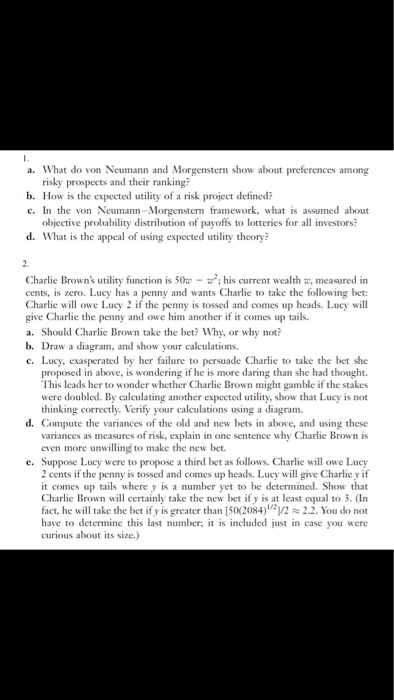more detail please! thanks!
1 a. What do von Neumann and Morgenstern show about preferences among risky prospects and their ranking b. How is the expected utility of a risk project defined? c. In the von Neumann-Morgenstern framework, what is assumed about objective probability distribution of payoffs to lotteries for all investors d. What is the appeal of using expected utility theory? 2. Charlie Brown's utility function is 50w - ; his current wealth , measured in cents, is zero. Lucy has a penny and wants Charlie to take the following bet: Charlie will owe Lucy 2 if the penny is tossed and comes up heads. Lucy will give Charlie the penny and owe him another if it comes up tails. 1. Should Charlie Brown take the bet? Why, or why not? b. Draw a diagram, and show your calculations, c. Lucy, exasperated by her failure to persuade Charlie to take the bet she proposed in above, is wondering if he is more daring than she had thought. This leads her to wonder whether Charlie Brown might gamble if the stakes were doubled. By calculating another expected utility show that Lucy is not thinking correctly. Verify your calculations using a diagram. d. Compute the variances of the old and new bets in above, and using these variances as measures of risk, explain in one sentence why Charlie Brown is even more unwilling to make the new bet. c. Suppose Lucy were to propose a third bet as follows. Charlie will owe Lucy 2 cents if the penny is tossed and comes up heads. Lucy will give Charlie y if it comes up tails where y is a number yet to be determined. Show that Charlie Brown will certainly take the new bet if y is at least oqual to 3. (In fact, he will take the bet ify is greater than [50(2084)/2 22.2. You do not have to determine this last number, it is included just in case you were curious about its size.) 1 a. What do von Neumann and Morgenstern show about preferences among risky prospects and their ranking b. How is the expected utility of a risk project defined? c. In the von Neumann-Morgenstern framework, what is assumed about objective probability distribution of payoffs to lotteries for all investors d. What is the appeal of using expected utility theory? 2. Charlie Brown's utility function is 50w - ; his current wealth , measured in cents, is zero. Lucy has a penny and wants Charlie to take the following bet: Charlie will owe Lucy 2 if the penny is tossed and comes up heads. Lucy will give Charlie the penny and owe him another if it comes up tails. 1. Should Charlie Brown take the bet? Why, or why not? b. Draw a diagram, and show your calculations, c. Lucy, exasperated by her failure to persuade Charlie to take the bet she proposed in above, is wondering if he is more daring than she had thought. This leads her to wonder whether Charlie Brown might gamble if the stakes were doubled. By calculating another expected utility show that Lucy is not thinking correctly. Verify your calculations using a diagram. d. Compute the variances of the old and new bets in above, and using these variances as measures of risk, explain in one sentence why Charlie Brown is even more unwilling to make the new bet. c. Suppose Lucy were to propose a third bet as follows. Charlie will owe Lucy 2 cents if the penny is tossed and comes up heads. Lucy will give Charlie y if it comes up tails where y is a number yet to be determined. Show that Charlie Brown will certainly take the new bet if y is at least oqual to 3. (In fact, he will take the bet ify is greater than [50(2084)/2 22.2. You do not have to determine this last number, it is included just in case you were curious about its size.)







